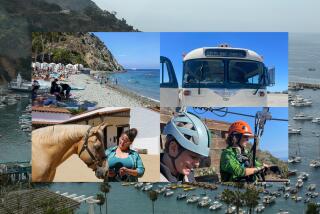Vintage Spirits in the Sky
Pilot Jose Diaz, 28, and co-pilot Mike Jones, 30, run through the preflight check list for an airplane that is almost twice their age.
“Propellers. Check. Parking brake. Set. Wing flaps. Up and neutral.”
Diaz flips a toggle switch on the instrument panel and the fuel pumps whir. “Clear!” he yells out the side window. The engines start with a rumble and a cloud of gray exhaust. A shudder goes through the fuselage. In the cockpit, the noise and vibration are so bad that it is hard to talk.
“Radio. Set. Temperature and pressures. Good for taxi. Everything normal.” Diaz advances the throttles for the two radial engines. The plane gathers speed on the runway and becomes airborne. It wiggles and bobs in the turbulence before reaching smooth air. “Gear up.”
Diaz and Jones are flying in the past.
Both pilots work for Catalina Flying Boats Inc. of Long Beach, one of the few air cargo companies in the United States that fly DC-3s--the famed civilian and military transports that last rolled off the assembly line 54 years ago.
The company has acquired two of the old planes for its charter service and main cargo operation to Santa Catalina Island, about 26 miles away. Flown almost daily, the blue, white and gray aircraft with their rumbling piston engines are a familiar sight in the skies over Long Beach.
People often come by the company’s headquarters at the Long Beach Airport to look at the planes and take pictures through the chain-link fence, said Steve Franklin, the president and owner of Catalina Flying Boats.
Some of the onlookers once flew DC-3s. Or their fathers jumped out of them as paratroopers during World War II.
“We operate the older stuff because they are the best planes for the types of runs we have,” Franklin said. “Still, there are times when you go out on the ramp and the engines are firing up. There’s the smell of exhaust and the rumble of those old motors. It kinda brings a tear to your eye. These planes are classics like a ’55 Chevy or a ’56 T-Bird.”
Aviation historians said that about 300 DC-3s are still flying in the United States. About 100 are owned by commercial companies like Catalina Flying Boats and the rest by collectors and museums. Overall, about 1,500 to 2,000 remain in service worldwide.
Douglas Aircraft Co. produced 10,655 DC-3s in the United States between 1935 and 1946; another 4,000 were made under Douglas licenses in Russia and Japan. Most of the U.S. production were C-47s, the military version of the aircraft.
What has contributed to the DC-3’s survival is its rugged construction, 7,500-pound cargo capacity, and relatively low cost compared with that of modern aircraft with similar capabilities.
Airworthy DC-3s can be purchased for $150,000. In comparison, modern turbo-props with an equivalent cargo capacity cost about $1 million. There are smaller planes that can match the DC-3’s hourly flying cost of $600 to $700, but they carry far less cargo.
The DC-3s owned by Catalina Flying Boats were built in Oklahoma City in 1945 under an Army Air Corps contract.
Before its civilian reincarnation, one of them hauled munitions in Burma toward the end of World War II. The other served the Navy and a variety of federal agencies for 22 years.
Both were sold as surplus and were used by a number of smaller airlines until Catalina bought them in 1992 and 1995.
Keeping the old transports aloft are five technicians supervised by Rowland Talkington, 69, a former Air Force mechanic with decades of experience repairing the radial engines that power the DC-3.
“The airplanes are in good shape. I enjoy working on them,” said Talkington, who used to work on B-29 bombers before joining a number of small airlines in civilian life.
“I think we can get another 20 years out of them, maybe more if the Federal Aviation Administration will let us.”
On Santa Catalina Island, the planes shuttle into a small airport with a bare-bones terminal--no building, just a patch of dirt and gravel to the side of the asphalt runway. When the DC-3s taxi, the area fills with dust.
Franklin estimates that the airline ferries about 10,000 to 20,000 pounds of freight a day to Catalina, including electronics, clothes, food, sundries, the U.S. mail, newspapers, clay pigeons and cases of liquor that fuel the island’s summer revelry.
Getting the cargo there is the fun part.
“I love it,” said Diaz, who is trying to log enough hours in the air to qualify for pilot training at a major airline. “The DC-3 is a big, heavy plane. You really have to fly it. You really have to manhandle the controls.”
Nothing is power-assisted in the cockpit. There are no automatic pilots or sophisticated navigation systems. The only links to the computer age are small calculators the pilots have taped or screwed to the instrument panel.
Like the rest of the DC-3s still in service, Catalina’s planes fly low and slowly--usually 140 mph at 1,000 feet for the 15-minute hop.
It is a pleasant flight. Sailboats and cargo ships pass below. Mountains, sea and sky are clearly visible from the cockpit. The airspeed is so slow that it hardly seems as if the plane is moving.
As Queen’s Gate and the harbor breakwater pass below, Diaz and Jones begin their approach to Long Beach Airport. After crossing the shoreline, Diaz makes several turns and lowers the landing gear. The DC-3 drifts slowly down until the wheels hit the runway with a screech and the fuselage settles back on the tail wheel. The past has arrived again.
More to Read
Sign up for The Wild
We’ll help you find the best places to hike, bike and run, as well as the perfect silent spots for meditation and yoga.
You may occasionally receive promotional content from the Los Angeles Times.






